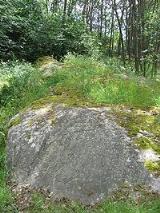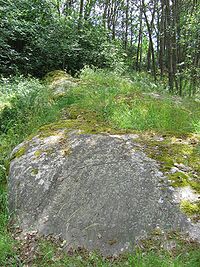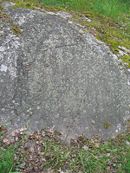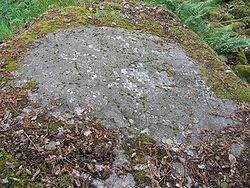
Hargs bro runic inscriptions
Encyclopedia


- Main article: Jarlabanke RunestonesJarlabanke RunestonesThe Jarlabanke Runestones is the name of c. 20 runestones written in Old Norse with the Younger Futhark in 11th century, Uppland, Sweden.They were ordered in the by what appears to have been a chieftain named Jarlabanke Ingefastsson and his clan , in Täby...
The Hargs bro runic inscriptions, or U 309, U 310 and U 311, are 11th century Younger Futhark
Younger Futhark
The Younger Futhark, also called Scandinavian runes, is a runic alphabet, a reduced form of the Elder Futhark, consisting of only 16 characters, in use from ca. 800 CE...
inscriptions in Old Norse
Old Norse
Old Norse is a North Germanic language that was spoken by inhabitants of Scandinavia and inhabitants of their overseas settlements during the Viking Age, until about 1300....
on bedrock in Skånela Parish, Uppland
Uppland
Uppland is a historical province or landskap on the eastern coast of Sweden, just north of Stockholm, the capital. It borders Södermanland, Västmanland and Gästrikland. It is also bounded by lake Mälaren and the Baltic sea...
, Sweden
Sweden
Sweden , officially the Kingdom of Sweden , is a Nordic country on the Scandinavian Peninsula in Northern Europe. Sweden borders with Norway and Finland and is connected to Denmark by a bridge-tunnel across the Öresund....
.
U 309 and U 310 constitute a twin monument in the style Pr4 and they are thus dated to the period 1060-1100. They belong to a group of c. 20 runestones called the Jarlabanke Runestones
Jarlabanke Runestones
The Jarlabanke Runestones is the name of c. 20 runestones written in Old Norse with the Younger Futhark in 11th century, Uppland, Sweden.They were ordered in the by what appears to have been a chieftain named Jarlabanke Ingefastsson and his clan , in Täby...
that are connected to the local strongman Jarlabanke and his clan
Norse clans
The Scandinavian clan or ætt was a social group based on common descent or on the formal acceptance into the group at a þing.-History:...
. Together with the Broby bro Runestones
Broby bro Runestones
At Broby bro in Uppland, Sweden there are six runestones. U 139, U 140 and U 151 still stand by the road, but U 135, U 136 and U 137 have been moved a distance away from the road....
and the Uppland Rune Inscriptions 101, 143 and 147
Uppland Rune Inscriptions 101, 143 and 147
The runestones known as U 101, U 143 and U 147, are located in south-western Täby, in the parishes of Sollentuna and Täby, in Uppland, Sweden. They are all in the style Pr4 and thus dated to the period 1060-1100 during which they were carved in connection with the construction of a road from Hagby...
these particular runestones, however, treat the female matriarch of the clan called Estrid
Estrid
Estrid was a rich and powerful 11th century Swedish woman whose long family saga has been recorded on five or six runestones in Uppland, Sweden. This Estrid was the maternal grandmother of the chieftain Jarlabanke of the Jarlabanke clan...
.
U 310 tells that Estrid had a husband named Ingvar, and he had a son prior to marrying Estrid, named Ragnvald
Ragnvald Ingvarsson
Ragnvaldr was a captain of the Varangian Guard in the first half of the 11th century. He may appear on several runestones, some of which suggest that he was the son of an Ingvar connecting him to the Jarlabanke clan....
who died. Estrid constructed a bridge, apparently a tradition in her family.
U 309 mentions Sigvid, Ingvar and Jarlabanke in a way that suggests that they are Estrid's sons. This Jarlabanke is not the same one as the Jarlabanke who raised the runestones in Täby
Täby
Täby is a trimunicipal locality and the seat of Täby Municipality in Stockholm County, Sweden, with 58,593 inhabitants in 2005. It is also partly located in Danderyd Municipality and Sollentuna Municipality...
, because he was the son of an Ingefast and a Jorun.
These runestones show a peculiarity to this family: the sons often have the same name as their fathers.
Estrid is the same person as the Estrid who is mentioned on a number of runestones in Täby
Täby
Täby is a trimunicipal locality and the seat of Täby Municipality in Stockholm County, Sweden, with 58,593 inhabitants in 2005. It is also partly located in Danderyd Municipality and Sollentuna Municipality...
and other locations (the Broby bro Runestones
Broby bro Runestones
At Broby bro in Uppland, Sweden there are six runestones. U 139, U 140 and U 151 still stand by the road, but U 135, U 136 and U 137 have been moved a distance away from the road....
and Uppland Rune Inscriptions 101, 143 and 147
Uppland Rune Inscriptions 101, 143 and 147
The runestones known as U 101, U 143 and U 147, are located in south-western Täby, in the parishes of Sollentuna and Täby, in Uppland, Sweden. They are all in the style Pr4 and thus dated to the period 1060-1100 during which they were carved in connection with the construction of a road from Hagby...
). This Estrid was the maternal ancestor of a great clan called the Jarlabanke clan, and she was the maternal grandmother of the powerful Jarlabanke who claimed to own all of Täby.
The carver of the Snottsta runestone
Snottsta and Vreta stones
The Snottsta and Vreta stones are individual runestones known as U 329, U 330, U 331 and U 332. They are found on the homesteads of Snottsta and Vreta, and they tell in Old Norse with the younger futhark about the family story of Gerlög and Inga in 11th century Uppland, Sweden, together with the...
called U 329, where an Estrid and her brother Ragnfast are mentioned, is believed to be the runemaster
Runemaster
A runemaster or runecarver is a specialist in making runestones.Most early medieval Scandinavians were probably literate in runes, and most people probably carved messages on pieces of bone and wood. However, it was difficult to make runestones, and in order to master it one also needed to be a...
named Fot
Fot
Fot was a runemaster who flourished in mid-11th century Sweden.-Career:Most early medieval Scandinavians were probably literate in runes, and most people probably carved messages on pieces of bone and wood. However, it was difficult to make runestones, and in order to master it one also needed to...
who also made the runestones for the Jarlabanke clan. This strongly suggests that Estrid was born in Snottsta (also spelled Snåttsta), married Östen of Täby and married for the second time in Harg near Snottsta.
U 309

Ragnvald Ingvarsson
Ragnvaldr was a captain of the Varangian Guard in the first half of the 11th century. He may appear on several runestones, some of which suggest that he was the son of an Ingvar connecting him to the Jarlabanke clan....
.
Transliteration of the runes into Latin characters
- × sikuiþr × auk × in[kua]r × auk × iarlabanki × litu × rista × runaR × at inkuar × faþur × sin × auk × at raknualt × broþur sin +
Transcription into Old NorseOld NorseOld Norse is a North Germanic language that was spoken by inhabitants of Scandinavia and inhabitants of their overseas settlements during the Viking Age, until about 1300....
- Sigviðr ok Ingvarr ok Iarlabanki letu rista runaR at Ingvar, faður sinn, ok at Ragnvald, broður sinn.
Translation in English
- Sigviðr and Ingvarr and Jarlabanki had the runes carved in memory of Ingvarr, their father, and in memory of Ragnvaldr, their brother.
U 310

Ragnvald Ingvarsson
Ragnvaldr was a captain of the Varangian Guard in the first half of the 11th century. He may appear on several runestones, some of which suggest that he was the son of an Ingvar connecting him to the Jarlabanke clan....
. However, this one was made on the orders of Estrid (Ástríðr), Ingvar's wife who was not Ragnvald's mother.
Transliteration of the runes into Latin characters
- × estriþ × lit × bro × kiara × eftiR × ikuar × bonta × sin × auk × at raknualt × sun × hans ×
Transcription into Old Norse
- Æstrið let bro gæra æftiR Ingvar, bonda sinn, ok at Ragnvald, sun hans.
Translation in English
- Ástríðr had the bridge made in memory of Ingvarr, her husbandman, and in memory of Ragnvaldr, his son.
U 311

Transliteration of the runes into Latin characters
- inkriþ ' lit ' kiara ' bro ' iftiR * inkikiari ' totur ' sin inkihualtr ' inkimar ' karl ' litu ' at ' systur s'i[n]
Transcription into Old Norse
- Ingrið let gæra bro æftiR Ingigærði, dottur sina. Ingivaldr, Ingimarr, Karl letu at systur sina.
Translation in English
- Ingríðr had the bridge made in memory of Ingigerðr, her daughter. Ingivaldr (and) Ingimarr (and) Karl had (it made) in memory of their sister.
How to find them?
In the gallery is a rough map of the area. You can find the stones by finding the Harsbro busstop. From there go south over the bridge and soon after you will find a grass-path to the right into the forest. Follow it until you see the small information sign on the left of the path.Sources
- RundataRundataThe Scandinavian Runic-text Data Base is a project involving the creation and maintenance of a database of runic inscriptions. The project's goal is to comprehensively catalog runestones in a machine-readable way for future research...
- Inga och Estrid - en såpa för tusen år sedan: Människor, händelser och platser i Ingas och Estrids liv. A page at the Museum of Stockholm County website.

